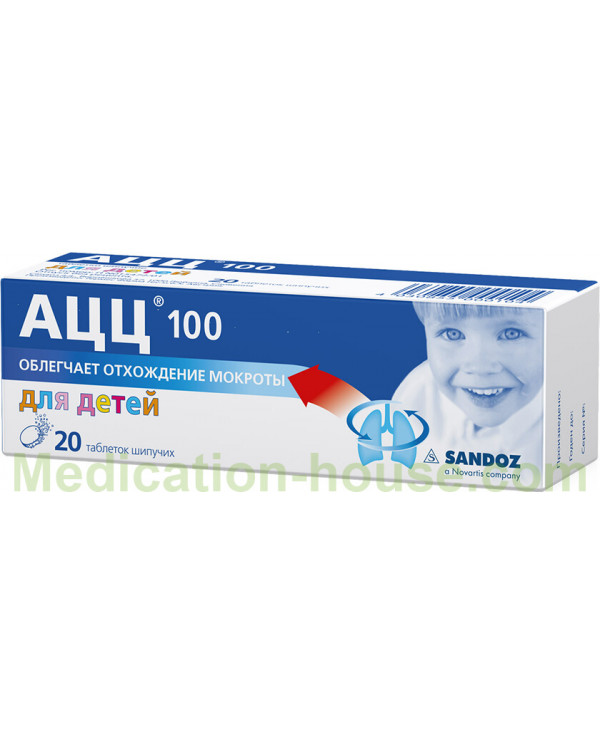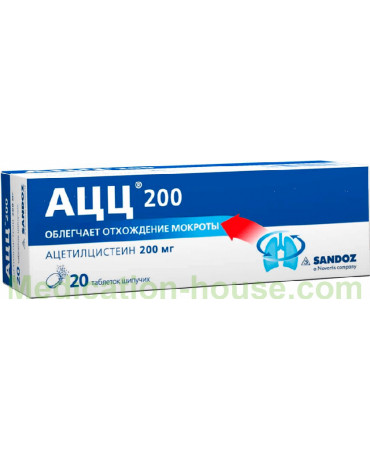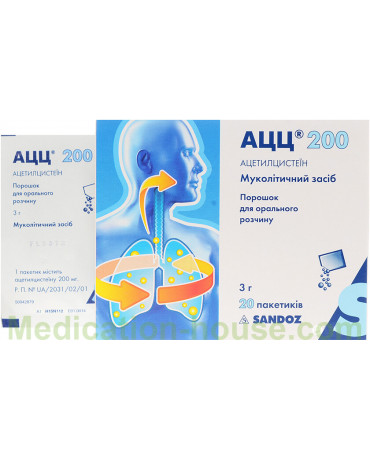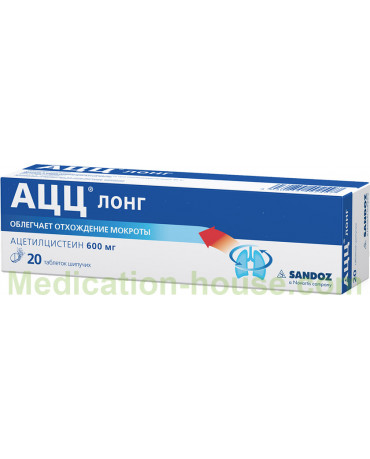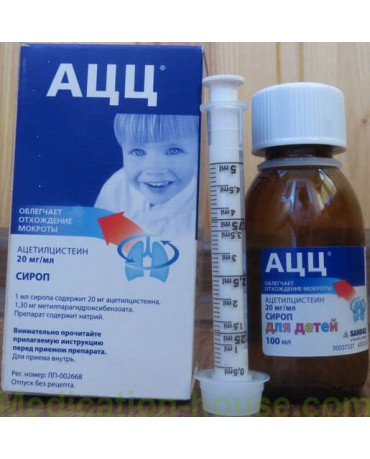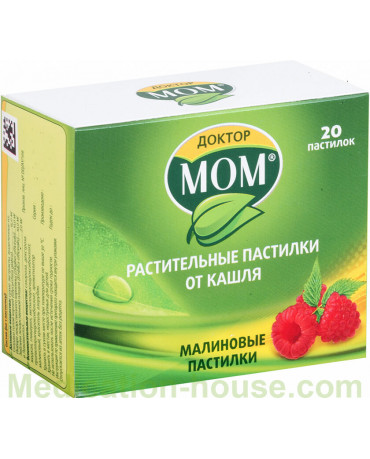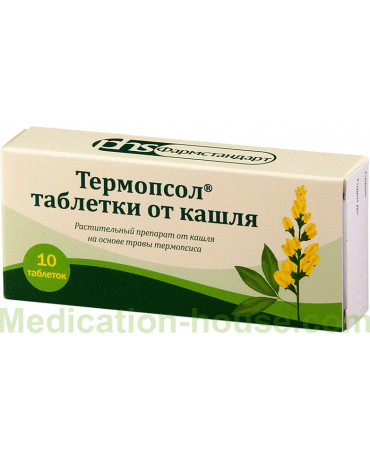Instruction for ACC 100
Reed more and buy ACC 100 here
Composition
1 tablet contains:
Active substance: acetylcysteine 100 mg.
Excipients: citric acid anhydride - 679.85 mg, sodium bicarbonate - 291 mg, mannitol - 65 mg, ascorbic acid - 12.5 mg, lactose anhydride - 75 mg, sodium citrate - 0.65 mg, saccharin - 6 mg, blackberry flavor "B" - 20 mg.
Pharmacological action
Mucolytic drug. The presence of sulfhydryl groups in the structure of the acetylcysteine molecule promotes the disruption of the disulfide bonds of acid mucopolysaccharides of sputum, which leads to a decrease in the viscosity of mucus. It has a mucolytic effect, facilitates sputum discharge due to a direct effect on the rheological properties of sputum. The drug remains active in the presence of purulent sputum.
With the prophylactic use of acetylcysteine, a decrease in the frequency and severity of exacerbations in patients with chronic bronchitis and cystic fibrosis is noted.
Indications
Respiratory diseases accompanied by increased formation of viscous, difficult to separate sputum (acute and chronic bronchitis, obstructive bronchitis, pneumonia, bronchiectasis, bronchial asthma, bronchiolitis, cystic fibrosis).
Acute and chronic sinusitis.
Otitis media.
Contraindications
Peptic ulcer of the stomach and duodenum in the acute phase.
Hemoptysis.
Pulmonary hemorrhage.
Pregnancy.
Lactation (breastfeeding).
Hypersensitivity to the components of the drug.
With caution: the drug should be used in patients with varicose veins of the esophagus, with an increased risk of pulmonary hemorrhage and hemoptysis, with bronchial asthma, diseases of the adrenal glands, liver and / or renal failure.
Use during pregnancy and lactation
Due to insufficient data, the use of the drug during pregnancy and lactation is possible only in cases where the expected benefits to the mother outweigh the potential risk to the fetus or child.
Dosage and administration
Adults and adolescents over 14 years of age: it is recommended to prescribe a drug of 200 mg 2-3 times / day (ACC 100 or ACC 200), which corresponds to 400-600 mg of acetylcysteine per day.
Children aged 6 to 14 years: it is recommended to take 1 tab. (ACC 100) or 1/2 tab. (ACC 200) 3 times / day, or 1 tab. (ACC 200) 2 times / day, which corresponds to 300-400 mg of acetylcysteine per day.
Children aged 2 to 5 years: the drug is recommended to take 1 tab. (ACC 100) or 1/2 tab. (ACC 200) 2-3 times / day, which corresponds to 200-300 mg of acetylcysteine per day.
With cystic fibrosis: for children over 6 years of age, the drug is recommended to take 2 tablets. (ACC 100) or 1 tab. (ACC 200) 3 times / day, which corresponds to 600 mg of acetylcysteine per day. Children aged 2 to 6 years - 1 tab. (ACC 100) or 1/2 tab. (ACC 200) 4 times / day, which corresponds to 400 mg of acetylcysteine per day. For patients with a body weight of more than 30 kg with cystic fibrosis, if necessary, you can increase the dose to 800 mg / day.
For short-term colds: the duration of administration is 5-7 days. In chronic bronchitis and cystic fibrosis, the drug should be used longer for the prevention of infections.
The drug should be taken after meals. An additional intake of fluid enhances the mucolytic effect of the drug.
Effervescent tablets (ACC 100 and ACC 200) should be dissolved in 1/2 cup of water. Take immediately after dissolution, in exceptional cases, you can leave the finished solution for 2 hours.
Side Effects
From the nervous system: rarely - headache, tinnitus.
From the digestive system: rarely - stomatitis; very rarely - diarrhea, vomiting, heartburn and nausea.
From the cardiovascular system: very rarely - a decrease in blood pressure, tachycardia.
Allergic reactions: in isolated cases - bronchospasm (mainly in patients with bronchial hyperreactivity), skin rash, itching, and urticaria.
Other: in isolated cases - the development of bleeding as a manifestation of a hypersensitivity reaction.
Special instructions
In case of bronchial asthma and obstructive bronchitis, acetylcysteine should be prescribed with caution under the systematic control of bronchial obstruction.
With the development of adverse reactions, the patient should stop taking the drug and consult a doctor.
When dissolving the drug, it is necessary to use glassware, avoid contact with metals, rubber, oxygen, easily oxidized substances.
In patients with diabetes mellitus, it is necessary to take into account that 1 effervescent tablet of ACC 100 and ACC 200 corresponds to 0.006 XE.
Influence on the ability to drive vehicles and control mechanisms
There is no data on the negative effect of the drug in recommended doses on the ability to drive vehicles and perform other activities that require concentration and speed of psychomotor reactions.
Drug Interactions
With the simultaneous use of acetylcysteine and antitussive agents due to suppression of the cough reflex, dangerous mucus congestion can occur (use the combination with caution).
With the simultaneous administration of acetylcysteine and nitroglycerin, it is possible to enhance the vasodilating effect of nitroglycerin.
A synergism of acetylcysteine with bronchodilators was noted.
Acetylcysteine reduces the absorption of cephalosporins, penicillins and tetracycline, so they should be taken orally no earlier than 2 hours after taking acetylcysteine.
Acetylcysteine is pharmaceutically incompatible with antibiotics (penicillins, cephalosporins, erythromycin, tetracycline and amphotericin B) and proteolytic enzymes.
Upon contact with acetylcysteine with metals, rubber sulfides are formed with a characteristic odor.
Overdose of ACC
In case of an erroneous or deliberate overdose, symptoms such as diarrhea, vomiting, stomach pain, heartburn, and nausea are observed. To date, no serious and life-threatening side effects have been observed.
Storage conditions
The drug should be stored out of the reach of children, in a dry place at a temperature not exceeding 25 ° C.
Terms of sell
You don't need a prescription to buy ACC 100.

